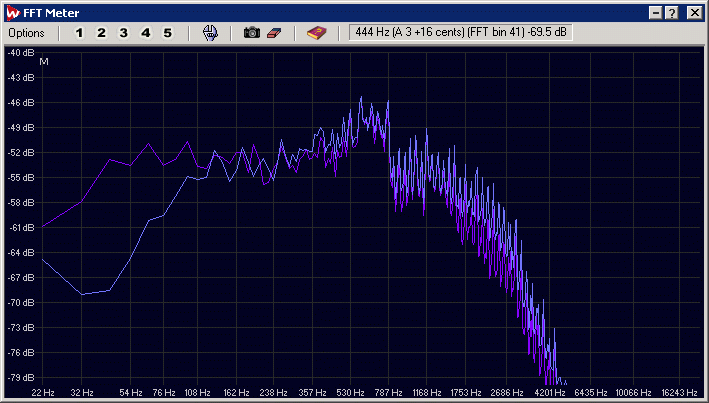Correcting Mic Responses
Eric Benjamin's Clicks
...or how to measure microphones without equipment!
If two microphones (in our case, say, an omni and a fig8) are placed together, and a click is recorded through them both (I use a dog-training clicker, but a child's toy, or a good finger snap would do as well), then by analysing just the beginning of the recording from each microphone (such a short section that only the direct sound is involved, and not the first reflection) and comparing the spectra, Eric Benjamin found that he could establish the relative sensitivity of the microphones within a fraction of a dB.
My first attempt at this failed miserably, because I didn't take a short enough section to analyse, but I am doing better now, particularly if I take care to take the same number of samples from each mic, starting at the exact same point.
Matching Capsule Sensitivities
So to align the three mics in the B-format setup, I do a few clicks at each of the compass points (with spoken identification for verification, of course), and then analyse the results. Once the relative sensitivities have been established, the levels of the three channels can be adjusted, not forgetting the standard B-format convention that the level of W is reduced by 3dB.
[illustration of analysis to follow]
Correcting Pressure Gradient Bass Roll-off
Velocity microphones have a natural 6dB/8ve fall-off in the bass; the design of the microphone determines at what frequency the turn-over to this is. Because of the bass rise that velocity microphones also show due to proximity effect, most mic designers are happy to leave directional mics bass-light at a distance. However, for recording at a distance (over about two metres counts), the bass fall-off can be corrected electronically.
Most small-diaphragm fig8 mics have their bass turn-over in the 150Hz - 200Hz region, so a simple 6dB/8ve rise from around 150Hz is suitable. Of course, at very low frequencies this could become embarrassing (note the rise at extreme LF in the graph below, which is typical, and probably mainly caused by air movement), so a sharp fall turning down around 30Hz to 50Hz is generally prudent - a compromise might be required if recording an organ!
Measuring where the bass fall-off begins in any mic is at first sight very difficult to do, and it seems that the manufacturers' specs are not often a reliable source of this information either. What I have done is made the outrageous assumption that if I take the averaged spectrum from each channel of my mic for everything I record in each large reverberant venue, I should be able to see where the omni and fig8 spectra start to move apart and so determine the turn-over point for the fig8. It seems to me that with my rose-tinted spectacles on I get consistent results between venues, and that I can consistently see a marked difference between my two fig8 capsules. At any rate, I now correct according to my interpretation of these spectra, and find the results reasonably convincing.
The spectra shown below are for my W (purple) and Y (blue) mics, calculated using WaveLab over the whole of a concert in Exeter College chapel. The fig8 capsules both have a sensitivity somewhat higher than the omni on average, and the Y one here consistently shows the bass turn-down at a distinctly lower frequency than the X one does (the fig8s are not well matched in the treble either, but I have only once got as far as trying to compensate for this). I have not relied on a single graph for working out my corrections, but have averaged the results from all the surround recordings I have made with these mics; it also helps to adjust the spectrum window to find a good compromise between a smooth graph and sufficient LF resolution.

Correcting the Omni Response
Because I place the omni capsule (W channel) pointing upwards, the main horizontal sound sources are 90 degrees off axis. The manufacturer's graphs show the fall off in HF response quite convincingly, and I boost the HF a little to compensate for this. As a result, of course, reverberation from above is boosted too much; but this is not dissimilar to the mild HF boost that many omni mics are given as "diffuse field" correction, and since I tend to record in large spaces I suspect that the HF loss in air quickly becomes greater as well. At any rate, no one has yet complained!
Because the extreme bass end of the fig8 response is sharply cut off to prevent these mics becoming a seismograph, I also follow a suggestion from Richard Lee to cut the extreme bass of the omni with the idea of matching the phase responses.
Applying the corrections
I use a simple parametric equaliser (minimum phase, not linear phase, as the effects we are correcting for are themselves minimum phase) to apply the corrections described above to each of the B-format channels before I do any further processing. The curves in the image below (cut from captures of the controls for the A0 Parametric Equaliser VST) show the corrections I currently apply to W and Y (the correction for X is similar, but starts at a somewhat higher frequency):


